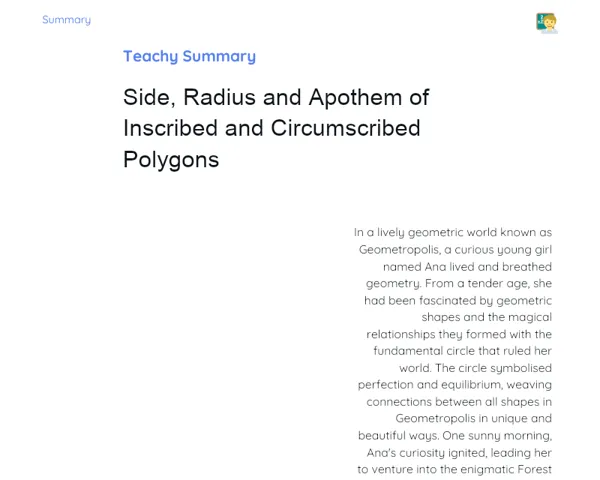Summary Tradisional | Area: Rectangle and Parallelogram
Contextualization
In this lesson, we’ll dive into calculating the area of rectangles and parallelograms, which are basic geometric shapes that pop up in mathematics and many real-life scenarios. A rectangle is a four-sided shape where opposite sides run parallel and are equal in length, with each angle being 90 degrees. A parallelogram also has opposite sides that are parallel and equal, but its angles can differ. Getting a handle on how to calculate the area of these shapes is essential, as it helps in practical tasks like measuring land, planning spaces, or figuring out how much building materials to buy.
The basic formula for finding the area of a rectangle or parallelogram is A = b x h, where 'b' is the base and 'h' is the height. This simple yet effective formula was established by ancient mathematicians and remains key across fields like engineering, architecture, and design. By mastering this formula, you’ll be equipped to calculate areas quickly and accurately, helping you tackle real-world problems and make better decisions in various day-to-day situations.
To Remember!
Definition of Rectangle
A rectangle is a four-sided figure with opposite sides that are parallel and equal in length. All angles in a rectangle are right angles at 90 degrees. This characteristic makes rectangles some of the simplest and most frequently encountered shapes, whether you’re looking at objects, buildings, or even screens on your devices.
Rectangles are commonly found in various fields, such as engineering, architecture, and design. For instance, when architects plan a house, they often use rectangles to layout rooms and calculate the space required for each area. Similarly, engineers may rely on rectangles for drafting plans and figuring out how much building materials are necessary.
Understanding what a rectangle is and its properties is crucial for correctly applying the area formula (A = b x h), where 'b' is the base and 'h' is the height of the rectangle. This comprehension is especially significant when addressing practical issues involving area calculations, such as determining the size of a property or the amount of flooring needed for a room.
-
Geometric figure with four sides.
-
Opposite sides are parallel and equal in length.
-
All internal angles are right angles (90 degrees).
Area Formula for Rectangles
The area of a rectangle can be calculated using the formula A = b x h, where 'A' is the area, 'b' is the base, and 'h' is the height. This formula is straightforward and user-friendly, making it a handy tool for tackling all sorts of practical problems. Its ease of use means it’s relevant from primary school all the way to professional fields like civil engineering and architecture.
To apply the formula, you first need to accurately measure the base and height of your rectangle. For instance, if a rectangle measures 8 meters in base and 5 meters in height, you multiply 8 by 5 to get an area of 40 square meters. This calculation comes in handy for various tasks, such as figuring out how much paint to buy for a wall or how much grass you’ll need for a garden.
Beyond its practical use, the area formula for rectangles helps students develop core math skills, including multiplication and understanding measurement units. When they solve problems using this formula, students strengthen their grasp of essential math concepts and enhance their ability to approach problems logically and systematically.
-
Formula: A = b x h.
-
'A' is the area, 'b' is the base, and 'h' is the height.
-
Practical application in different contexts, like building and decorating.
Definition of Parallelogram
A parallelogram is a geometric figure with four sides where opposite sides are parallel and equal in length. Unlike rectangles, the angles in a parallelogram don’t have to be right angles. Common examples of parallelograms include rhombuses and diamonds, which have unique properties regarding angles and side lengths.
Parallelograms are often used in practical applications, particularly in engineering and architecture. For example, when constructing roofs or ramps, parallelograms are frequently utilized for their sloped design. Furthermore, studying parallelograms is essential for grasping more complex geometric concepts, such as the area of composite figures and geometric transformations.
Grasping the definition and characteristics of a parallelogram is crucial for applying the area formula (A = b x h), where 'b' is the base and 'h' is the perpendicular height. This understanding allows one to solve real-world problems that involve area calculations, such as figuring out the area of a sloped lot or the materials needed for covering an irregular surface.
-
Geometric figure with four sides.
-
Opposite sides are parallel and equal in length.
-
Internal angles may not be right angles.
Area Formula for Parallelogram
The formula for finding the area of a parallelogram is A = b x h, where 'A' is the area, 'b' is the base, and 'h' is the height perpendicular to the base. Although this is the same formula used for rectangles, applying it to parallelograms requires careful attention to ensure that the height is measured perpendicular to the base.
To use the formula properly, first identify the base and then measure the height that is perpendicular to that base. For instance, if a parallelogram has a base of 10 cm and a height of 6 cm, the area is found by multiplying 10 by 6, giving an area of 60 square centimeters. This information is crucial in various scenarios, such as calculating the area of a sloped roof or uneven ground.
Along with its practical uses, the area formula for parallelograms is foundational for understanding other geometric figures and their characteristics. Tackling problems that employ this formula helps students to reinforce their understanding of geometric theories and improves their skills in solving complex issues in a logical, structured way.
-
Formula: A = b x h.
-
'A' is the area, 'b' is the base, and 'h' is the height perpendicular to the base.
-
Practical applications on sloped surfaces and uneven terrains.
Key Terms
-
Area: The measure of a geometric figure's surface, calculated in square units.
-
Rectangle: A four-sided geometric figure with right angles and equal opposite sides.
-
Parallelogram: A four-sided geometric figure with opposite sides that are parallel and equal in length.
-
Area Formula: A mathematical expression used to calculate the area of geometric figures.
-
Base (b): One side of a geometric figure used as a reference point for area calculations.
-
Height (h): The perpendicular distance between the base and the opposite side of a geometric figure.
Important Conclusions
In this lesson, we’ve looked at how to calculate the area of rectangles and parallelograms using the formula A = b x h. We understood that a rectangle is a four-sided shape with right angles, whereas a parallelogram has parallel and equal opposite sides, with angles that may differ. Accurately applying these formulas is key to tackling practical challenges, like measuring land area and estimating construction supplies needed.
This topic is important because it applies across various areas of study and everyday life. Being able to calculate areas is essential for careers in engineering, architecture, and interior design, and it also helps with everyday tasks like arranging furniture in a room or buying the right amount of flooring for a renovation.
We wrap up this lesson by reinforcing that the concepts learned about calculating areas not only aid in real-world problem-solving but also build foundational mathematical skills. We encourage students to keep exploring this topic and to apply what they’ve learned to real-life scenarios for a deeper understanding.
Study Tips
-
Review the practical examples we covered in class and try tackling similar problems at home to strengthen your understanding of the formulas.
-
Use visual aids like drawings and models to better understand geometric figures and the relationship between base and height.
-
Practice calculating the area of various objects and spaces around you, like a book, a picture on a wall, or a garden, to apply your knowledge in real-life scenarios.



